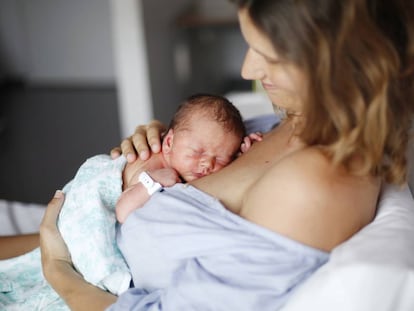A sensorized glove may be the key to reducing the number of stillborn babies
The device, which costs approximately $1 to make, can check the position of the fetus at the time of delivery

According to the World Health Organization, there are nearly two million stillbirths every year; 84% of cases occur in low-income countries and 40% are caused by childbirth complications. Looking to avoid some of these problems, a team of engineers and doctors from University College London (UCL) has developed a surgical glove with printed sensors to help doctors and childbirth specialists with difficult deliveries and to reduce neonatal mortality. The device, which costs around $1 to make, helps detect the position of the fetus and the force exerted during palpation.
Mechanical engineer Carmen Salvadores, co-leader of the project, points out that the most expensive part are the gloves themselves, “which hospitals already purchase anyway.” One of their strengths is “the simplicity of manufacturing,” adds the Spanish researcher; the sensors work with all the materials that are used to make surgical gloves, so they do not necessarily have to be latex.
During the tests, they placed a sterile glove over one with sensors to make sure that it could be used with the hygiene and sterilization conditions required in hospitals, and it worked exactly the same. “Our intention was always that it should adapt perfectly to what doctors normally do,” explains Salvadores. In addition, they made the sensors as thin as possible to increase user comfort: “The doctor is always able to feel and do everything in the same way, because they don’t notice it. It’s as if there is nothing there.”
The team of doctors and engineers made prototype fetal heads to test the effectiveness of the device. During palpation, the sensors help identify the fontanelles (the softer parts of the baby’s head, where the skull bones remain open). “When the doctor finds one, they perform a vaginal examination around it and confirm with the glove if it’s the front or back [of the head] for orientation.”
The sensorized glove can be connected to a computer or a smartphone via Bluetooth. The latter was devised with low-income countries in mind, as they “may not have the necessary computers or data acquisition systems,” says Salvadores. The team’s engineers are also working on a small device that is worn on the wrist like a bracelet, to send data to a mobile device.
While the glove is being worn, two images appear on the screen: one shows a red diamond (the front of the head) or a green triangle (the back). “That’s a moment in which doctors have to be aware of many things, and they told us that they wanted something very simple to know where they are.” The other image is a traffic light that indicates the force the doctor is exerting during the examination and emits an alert if it is too much. In addition, just like they distinguish between the different areas of the baby’s head, the sensors can detect other anomalies in the mother’s anatomy.
Currently, hospitals use ultrasound machines that show the position of the baby in the mother’s womb, but there could be moments when there is no time to get one or there are none available, explains the researcher. “That was the whole point: how to get a quick determination of fetal position.”
Throughout the research process they consulted and assessed the ideas of a group of mothers who experienced difficult labors, to find out if they would accept the glove and what design they would prefer. “We wanted it to be as comfortable as possible, and for the patients to like it.” With the device they intend to improve safety in childbirth, but also comfort.
The women complained that during childbirth numerous vaginal examinations had to be carried out to find out the position of the baby, with the discomfort that this entails. “They kept telling us that they would like this to reduce the number of examinations they have to undergo,” explains the engineer.
The first results were shared in an article published in January in Frontiers magazine: the glove has been tested 100 times, being fully effective for detecting fontanelles. During palpation, the sensors can tell the harder surface from the softer one, explains the engineer.
This first test was carried out by the other project leader, obstetrician Shireen Jaufuraully. The next step now is for other doctors with different levels of training to test prototypes of the device. “We will work with medical students who have never performed a vaginal examination, with childbirth specialists, with doctors who have just finished their studies and with highly experienced specialists,” says Salvadores.
The point is to assess the usefulness of the sensorized glove during training. “Everyone has their own tactile perception and it is very difficult to teach someone how to assess a vaginal examination or how much force to apply.” The researchers believe that this is one of the uses of the glove that can have the most impact. If it works effectively in all trials, “they will be able to practice directly on people because, even if they do something wrong, it will prevent a serious mistake,” she concludes.
Sign up for our weekly newsletter to get more English-language news coverage from EL PAÍS USA Edition
Tu suscripción se está usando en otro dispositivo
¿Quieres añadir otro usuario a tu suscripción?
Si continúas leyendo en este dispositivo, no se podrá leer en el otro.
FlechaTu suscripción se está usando en otro dispositivo y solo puedes acceder a EL PAÍS desde un dispositivo a la vez.
Si quieres compartir tu cuenta, cambia tu suscripción a la modalidad Premium, así podrás añadir otro usuario. Cada uno accederá con su propia cuenta de email, lo que os permitirá personalizar vuestra experiencia en EL PAÍS.
¿Tienes una suscripción de empresa? Accede aquí para contratar más cuentas.
En el caso de no saber quién está usando tu cuenta, te recomendamos cambiar tu contraseña aquí.
Si decides continuar compartiendo tu cuenta, este mensaje se mostrará en tu dispositivo y en el de la otra persona que está usando tu cuenta de forma indefinida, afectando a tu experiencia de lectura. Puedes consultar aquí los términos y condiciones de la suscripción digital.
More information
Últimas noticias
Venezuela breaks energy agreements with Trinidad and Tobago due to alleged complicity with the US
The murder of Michele and Rob Reiner: A tale of horrific days in Hollywood
Trump orders a ‘complete blockade of sanctioned oil tankers’ going to and from Venezuela
Not all insomnia is the same: Study identifies five subtypes and paves the way for personalized treatment
Most viewed
- ‘El Limones’ and the growing union disguise of Mexican organized crime
- Christian Louboutin: ‘Young people don’t want to be like their parents. And if their parents wear sneakers, they’re going to look for something else’
- ‘We are dying’: Cuba sinks into a health crisis amid medicine shortages and misdiagnosis
- A mountaineer, accused of manslaughter for the death of his partner during a climb: He silenced his phone and refused a helicopter rescue
- The low-cost creative revolution: How technology is making art accessible to everyone









































